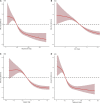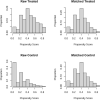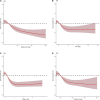Dietary metal intake and the prevalence of erectile dysfunction in US men: Results from National Health and Nutrition Examination Survey 2001-2004
- PMID: 36407550
- PMCID: PMC9668876
- DOI: 10.3389/fnut.2022.974443
Dietary metal intake and the prevalence of erectile dysfunction in US men: Results from National Health and Nutrition Examination Survey 2001-2004
Abstract
Background: Erectile dysfunction (ED) mainly affects men over 40 years of age and is a common clinical condition. In addition to hypertension and diabetes, environment, and lifestyle are also significantly associated with erectile dysfunction. The relationship between dietary trace metal intake and ED has not been studied.
Materials and methods: Data on participants were obtained from the National Health and Nutrition Examination Survey for this study, and those with incomplete information on clinical variables were excluded. Dose-response curve analysis was used to investigate the relationship between dietary trace metal intake and ED prevalence. Multivariate logistic regression analysis was used to adjust for confounders to further investigate the relationship between dietary trace metal intake and ED prevalence. 1:1 propensity score matching (PSM) was performed to adjust for differences between clinical variables for data reanalysis to confirm the reliability of the results.
Results: A total of 3,745 individuals were included in the study, including 1096 ED patients and 2,649 participants without ED. Dietary intake of trace metals (Mg, Zn, Cu, and Se) was significantly higher in participants without ED than in ED patients (all P < 0.001). Dose-response curve analysis showed a significant negative association between these dietary metal intakes and ED prevalence (all P < 0.001). Multivariate logistic regression analysis adjusted for confounders (age, education, BMI, annual household income, hypertension, diabetes, marital status, race, and current health status) revealed that increased dietary metal intake reduced the odds ratio of ED. 1:1 PSM reanalysis further confirmed the validity of the results.
Conclusion: Increasing dietary intake of trace metals (magnesium, zinc, copper, and selenium) within the upper limit is beneficial in reducing the prevalence of ED.
Keywords: National Health and Nutrition Examination Survey (NHANES); atherosclerosis; dietary trace metals intake; erectile dysfunction; nutrition.
Copyright © 2022 Liu, Li, Xu, Yu, Mao, Sun, Xu and Chen.
Conflict of interest statement
The authors declare that the research was conducted in the absence of any commercial or financial relationships that could be construed as a potential conflict of interest.
Figures






Similar articles
-
Lycopene intake and the risk of erectile dysfunction in US adults: NHANES 2001-2004.Andrology. 2024 Jan;12(1):45-55. doi: 10.1111/andr.13439. Epub 2023 Apr 20. Andrology. 2024. PMID: 37038051
-
Association between the composite dietary antioxidant index and erectile dysfunction in US men: a cross-sectional study.J Health Popul Nutr. 2024 Nov 11;43(1):184. doi: 10.1186/s41043-024-00653-w. J Health Popul Nutr. 2024. PMID: 39529149 Free PMC article.
-
Relationship between dietary niacin intake and erectile dysfunction: a population-based study.Asian J Androl. 2024 Jul 1;26(4):382-388. doi: 10.4103/aja202378. Epub 2024 Jan 30. Asian J Androl. 2024. PMID: 38305697 Free PMC article.
-
Association between polyunsaturated fatty acid intake and the prevalence of erectile dysfunction: A cross-sectional analysis of the NHANES 2001-2004.Lipids Health Dis. 2023 Oct 25;22(1):182. doi: 10.1186/s12944-023-01950-9. Lipids Health Dis. 2023. PMID: 37880723 Free PMC article.
-
Association between inflammatory indexes and erectile dysfunction in U.S. adults: National Health and Nutrition Examination Survey 2001-2004.Sex Med. 2023 Aug 9;11(4):qfad045. doi: 10.1093/sexmed/qfad045. eCollection 2023 Aug. Sex Med. 2023. PMID: 37577069 Free PMC article.
Cited by
-
Concentrations of Bioelements (Zn, Cu, Fe, Cr, Mg, Mn) in Serum and Bone Tissue of Aging Men Undergoing Hip Arthroplasty: Implications for Erectile Dysfunction.Biomolecules. 2024 May 9;14(5):565. doi: 10.3390/biom14050565. Biomolecules. 2024. PMID: 38785972 Free PMC article.
-
Associations of dietary inflammatory index and composite dietary antioxidant index with erectile dysfunction and the mediating role of metabolic dysregulation: a cross-sectional analysis of NHANES 2001-2004 data.Front Nutr. 2025 Jun 3;12:1538874. doi: 10.3389/fnut.2025.1538874. eCollection 2025. Front Nutr. 2025. PMID: 40529428 Free PMC article.
-
Concentration of Selected Serum Trace Elements in Male Patients With Diabetic Erectile Dysfunction: A Case-Control Study.Am J Mens Health. 2025 Jan-Feb;19(1):15579883241307526. doi: 10.1177/15579883241307526. Am J Mens Health. 2025. PMID: 39991892 Free PMC article.
-
Unraveling the Causal Association Between Circulating Copper Levels and Erectile Dysfunction: A Comprehensive Analysis via Bidirectional Two Sample Mendelian Randomization Study.Food Sci Nutr. 2025 May 26;13(6):e70247. doi: 10.1002/fsn3.70247. eCollection 2025 Jun. Food Sci Nutr. 2025. PMID: 40444123 Free PMC article.
-
Association between serum albumin levels and erectile dysfunction in American Adults: A cross-sectional study from NHANES 2001-2004.PLoS One. 2025 Feb 6;20(2):e0318147. doi: 10.1371/journal.pone.0318147. eCollection 2025. PLoS One. 2025. PMID: 39913554 Free PMC article.
References
-
- Consensus development conference statement. National institutes of health. Impotence. Int J Impot Res. (1993) 5:181–284. - PubMed
LinkOut - more resources
Full Text Sources
Miscellaneous

